Tom's Hardware Verdict
Trident Z5 RGB DDR5-6000 C36 is a genuine memory kit for performance seekers, but this level of performance comes with a steep price tag.
Pros
- +
Excellent performance
- +
Tight timings
- +
Good OC potential
Cons
- -
Costs an arm and a leg
Why you can trust Tom's Hardware
DDR5 is all the rage nowadays. However, the ongoing shortage and resulting steep pricing have scared potential customers away from the new memory kits. Intel's 12th Generation Alder Lake processors have embraced DDR5, but not all Alder Lake adopters have jumped on the bandwagon. Indeed, DDR5 is still in diapers, and first-generation memory kits have yet to demonstrate DDR5's full potential. Nonetheless, prominent brands like G.Skill have launched their high-end Trident Z5 lineup for hardcore enthusiasts that want to own the best of what DDR5 has to offer in the current stage of its product cycle.
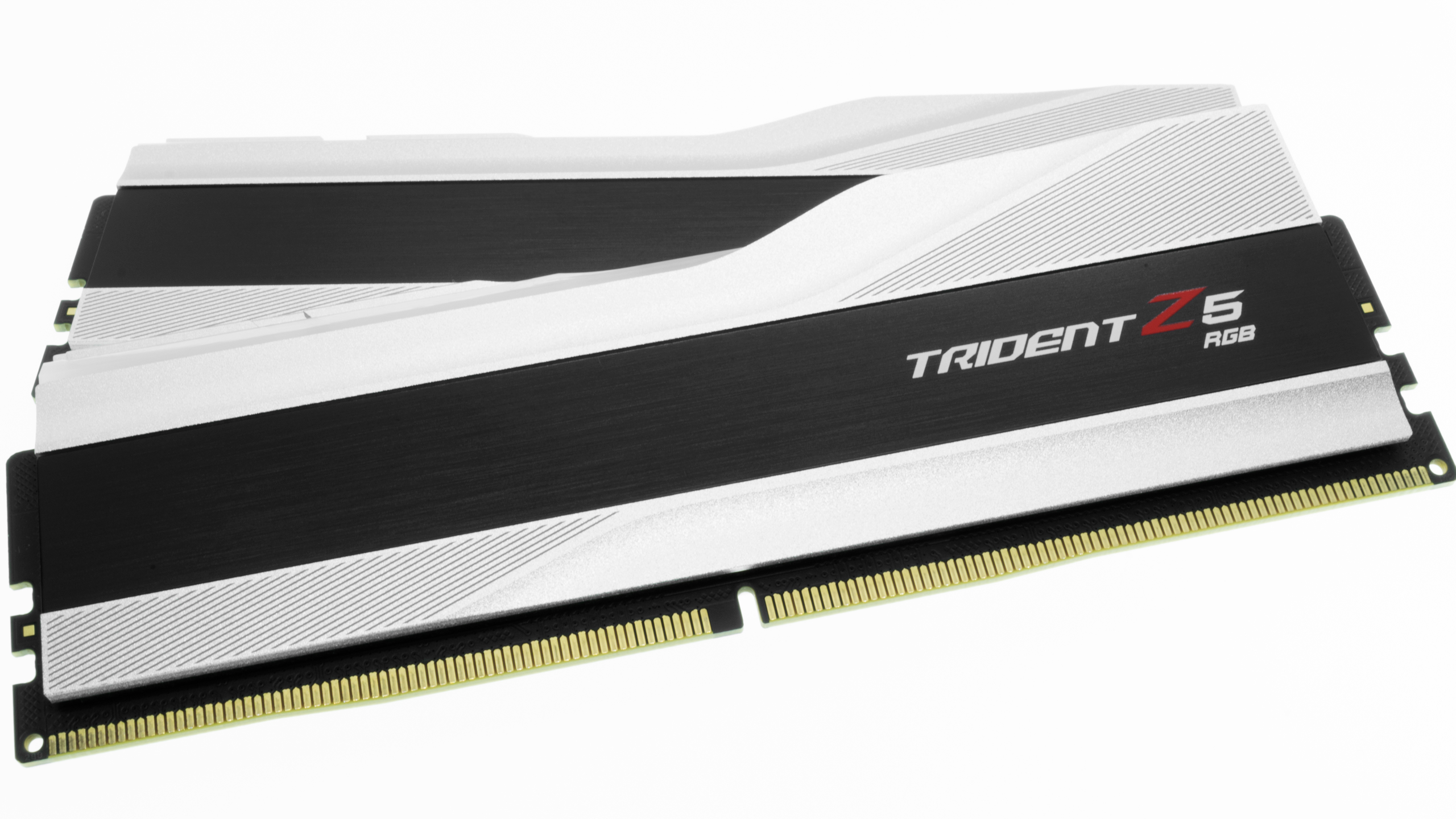


For this generation of the Trident series, G.Skill introduced the Trident Z5 and Trident Z5 RGB lineups. The latter features RGB lighting, which is also the variant in this review. Design-wise, the Trident Z5 RGB retains the trident theme with the fin design. In addition, the aluminum heat spreader flaunts a two-toned exterior and looks more elegant than previous Trident installments.
The Trident Z5 RGB measures 42mm (1.65 inches) tall with a heat spreader that comes in either metallic silver or matte black color of your choice. In addition, you'll find a translucent RGB light bar on the RGB variants and a regular plastic bar on the non-RGB versions. For the former, G.Skill includes the brand's proprietary Trident Z Lighting Control software, weighing in at 5.8MB. Finally, if you prefer your motherboard's software, the Trident Z5 RGB memory modules will play nice with Asus Aura Sync, Gigabyte RGB Fusion 2.0, MSI Mystic Light Sync, and ASRock Polychrome Sync.


The Trident Z5 RGB memory modules have a capacity of 16GB and adhere to a single-rank design. G.Skill chose Samsung's high-end K4RAH086VB-BCQK (B-die) integrated circuits for this particular memory kit, allowing it to hit very tight timings at the advertised data rate. The power management IC (PMIC) is from ANPEC and carries the model number APW8502C-AX93Q.
Before enabling the XMP 3.0 profile on the memory kit, it'll run at DDR5-4800 with 40-40-40-76 timings. Flipping on the switch will get the Trident Z5 RGB up to DDR5-6000 with 36-36-36-76 timings and a 1.3V DRAM voltage. For more on timings and frequency considerations, see our PC Memory 101 feature, as well as our How to Shop for RAM story.
Comparison Hardware
| Memory Kit | Part Number | Capacity | Data Rate | Primary Timings | Voltage | Warranty |
|---|---|---|---|---|---|---|
| G.Skill Trident Z5 RGB | F5-6000U3636E16GX2-TZ5RS | 2 x 16GB | DDR5-6000 (XMP) | 36-36-36-76 (2T) | 1.30 | Lifetime |
| TeamGroup T-Force Delta RGB | FF3D516G6000HC40ABK | 2 x 16GB | DDR5-6000 (XMP) | 40-40-40-80 (2T) | 1.35 | Lifetime |
| Corsair Dominator Platinum RGB DDR5 | CMT32GX5M2B5200C38 | 2 x 16GB | DDR5-5200 (XMP) | 38-38-38-84 (2T) | 1.25 | Lifetime |
| Kingston Fury Beast | KF552C40BBK2-32 | 2 x 16GB | DDR5-5200 (XMP) | 40-40-40-80 (2T) | 1.25 | Lifetime |
| Crucial | CT2K8G48C40U5 | 2 x 8GB | DDR5-4800 | 40-39-39-77 (2T) | 1.10 | Lifetime |
Our Intel testbed for DDR5 utilizes Intel's Core i9-12900K processor cooled with Corsair's CUE H100i Elite LCD liquid cooler. The flagship Alder Lake chip rests on an MSI MAG Z690 Tomahawk WiFi motherboard that runs the 7D32vH0 firmware. Meanwhile, the MSI GeForce RTX 2080 Ti Gaming Trio is responsible for our gaming RAM benchmarks.
Our Windows 11 installation, benchmarking software, and games are stored on Crucial's MX500 SSDs, whereas the RM650x feeds our entire system with the necessary juice. Lastly, the Streacom BC1 open bench table houses all of our hardware.
Get Tom's Hardware's best news and in-depth reviews, straight to your inbox.
| Header Cell - Column 0 | Intel DDR5 System |
|---|---|
| Processor | Intel Core i9-12900K |
| Motherboard | MSI MAG Z690 Tomahawk WiFi |
| Graphics Card | MSI GeForce RTX 2080 Ti Gaming X Trio |
| Storage | Crucial MX500 500GB, 2TB |
| Cooling | Corsair iCUE H100i Elite LCD |
| Power Supply | Corsair RM650x 650W |
| Case | Streacom BC1 |
Intel Performance



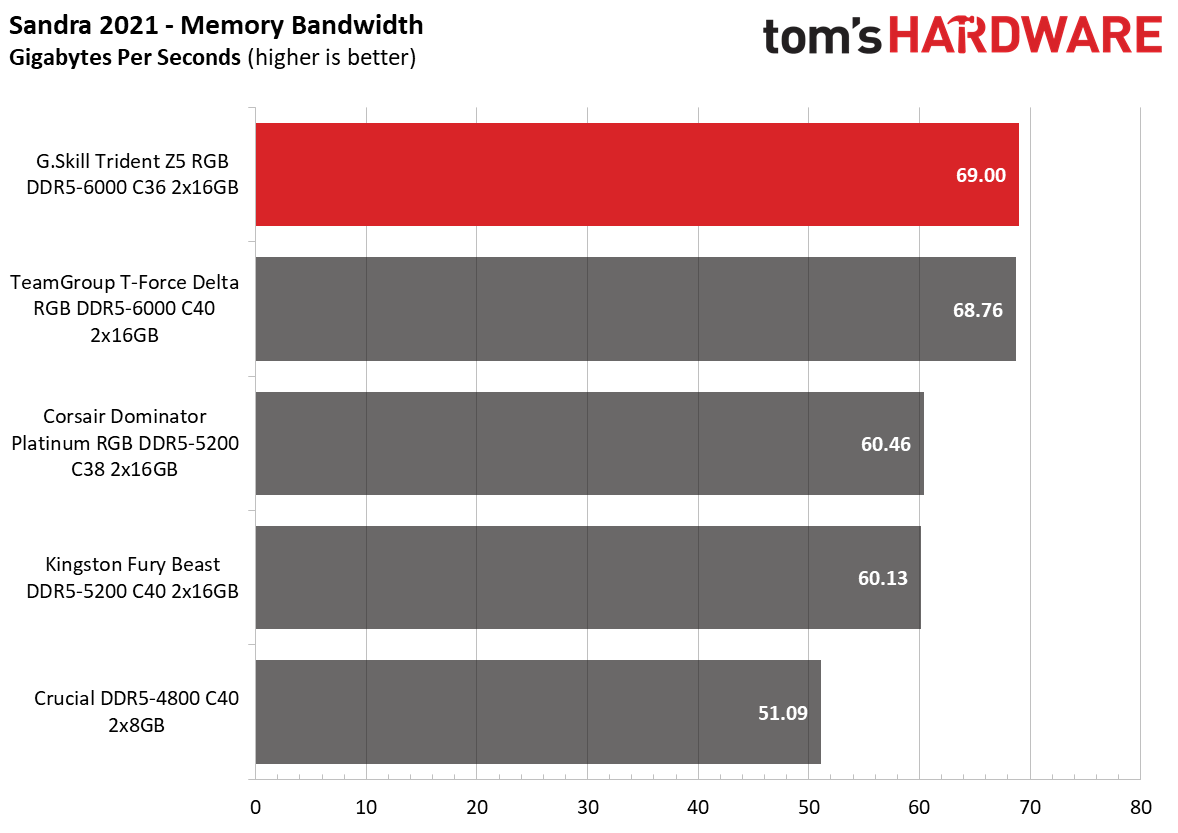
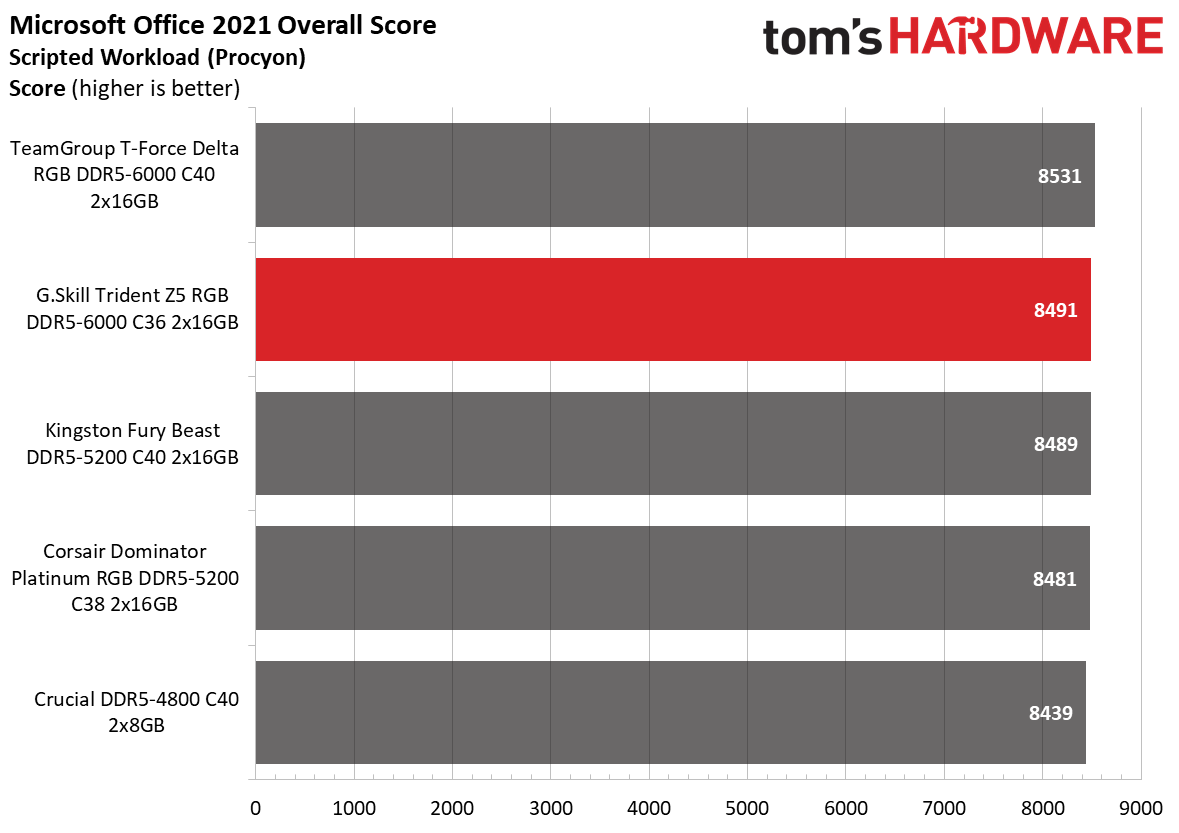


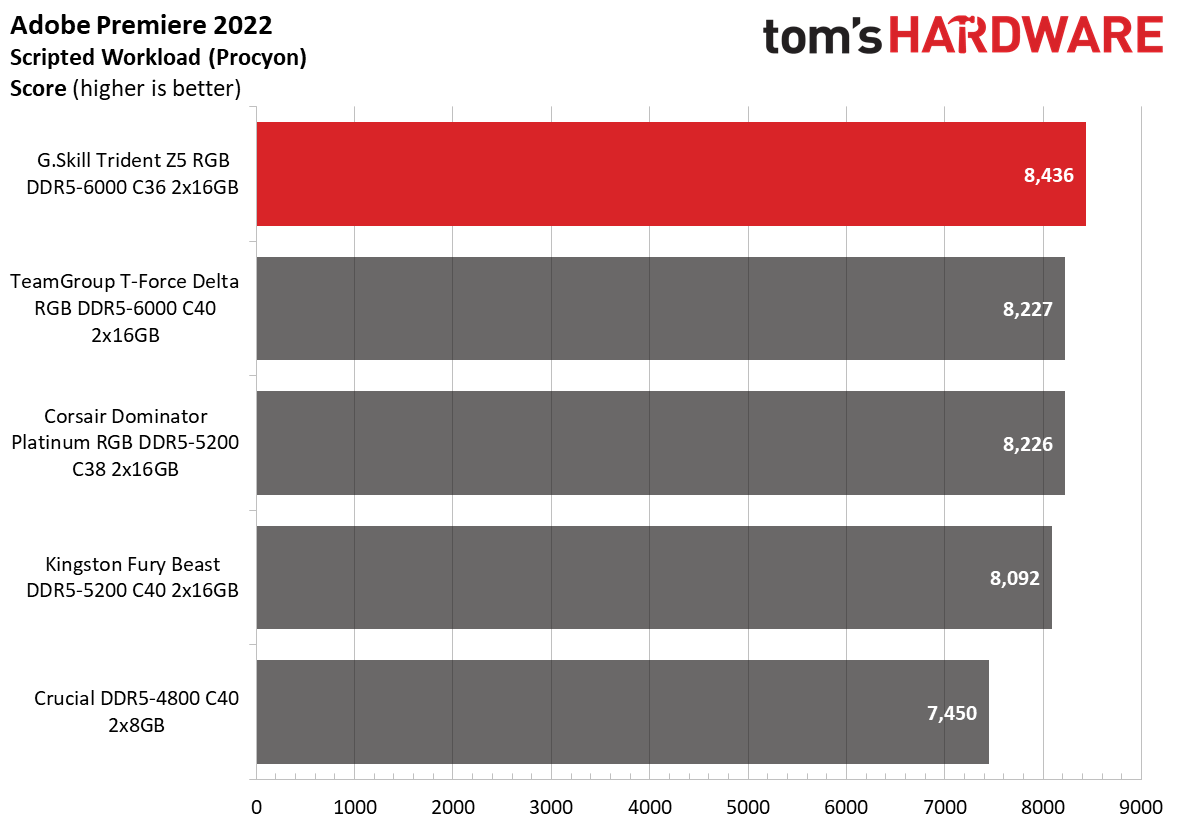










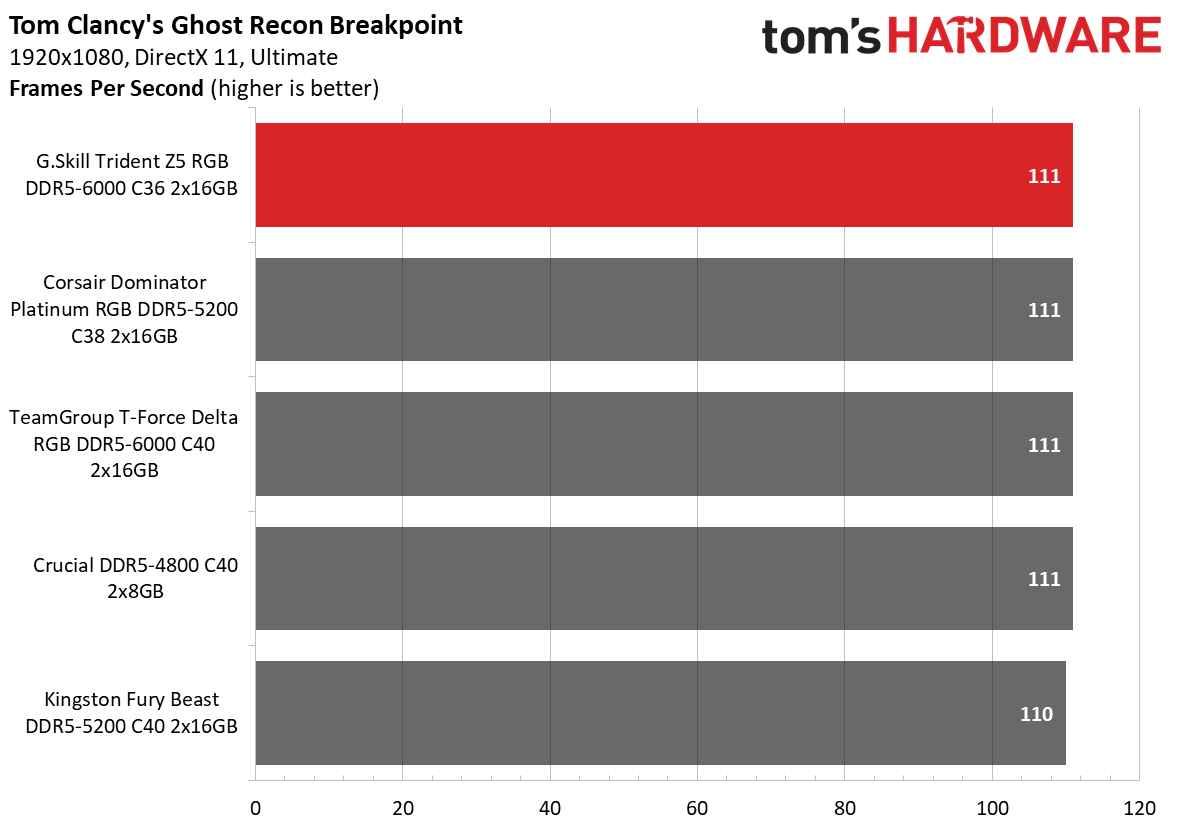

Cumulatively, the Trident Z5 RGB was the fastest memory kit to tackle our application test suite. It dominated the majority of the benchmarks. The memory kit was particularly exceptional in the Adobe Photoshop 2022 workload, where it outperformed the slowest memory kit by 20%.
Surprisingly, G.Skill's memory kit didn't fare too well in the gaming section as the Trident Z5 RGB finished in the middle of the pack.
Overclocking and Latency Tuning

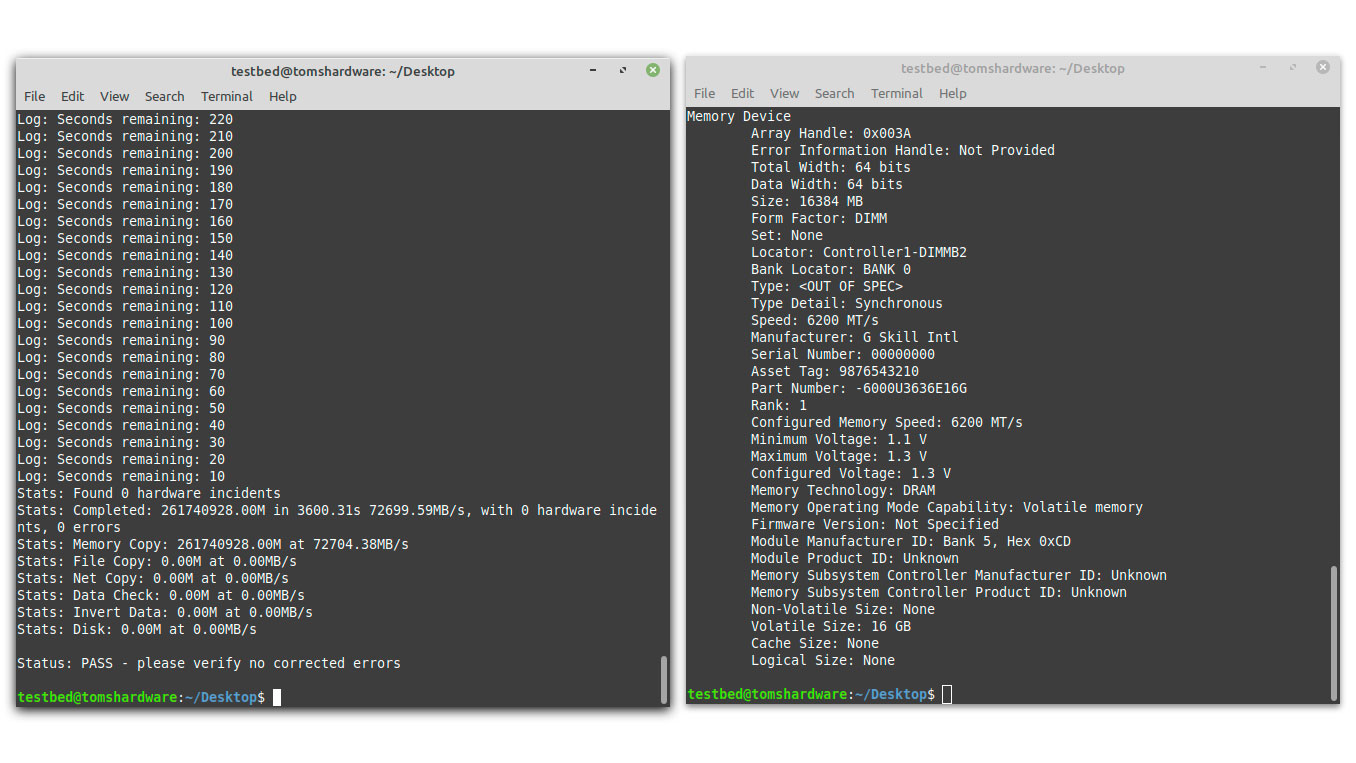

When you run hardware outside of the manufacturer's specifications, there's always a potential risk of damage. That's the standard caveat with overclocking any piece of hardware, not just memory.
Samsung told us that the company does not guarantee an overclocking voltage for its ICs. The absolute maximum DC of the drain voltage is 1.4V.
We managed to get DDR5-6200 out of the Trident Z5 RGB with the exact XMP memory timings (36-36-36-76). However, the memory did require us to bump the DRAM voltage from 1.3V up to 1.4V.
Lowest Stable Timings
| Memory Kit | DDR5-5200 (1.4V) | DDR5-5400 (1.4V) | DDR5-6000 (1.4V) | DDR5-6200 (1.4V) | DDR5-6400 (1.4V) |
|---|---|---|---|---|---|
| G.Skill Trident Z5 RGB DDR5-6000 C36 | N/A | N/A | 36-33-33-73 (2T) | 36-36-36-76 (2T) | N/A |
| TeamGroup T-Force Delta RGB DDR5-6000 C40 | N/A | N/A | 38-38-38-78 (2T) | N/A | 40-40-40-82 (2T) |
| Corsair Dominator Platinum RGB DDR5-5200 C38 | 34-37-37-77 (2T) | 40-40-40-76 (2T) | N/A | N/A | N/A |
| Kingston Fury Beast DDR5-5200 C40 | 36-37-37-78 (2T) | 38-38-38-78 (2T) | N/A | N/A | N/A |
| Crucial DDR5-4800 C40 | N/A | 40-40-40-77 (2T) | N/A | N/A | N/A |
Despite increasing the DRAM voltage to 1.4V, we couldn't lower the CAS Latency (CL) value any lower than 36 clocks. Oddly enough, the tRCD, tRP, and tRAS timings were stable at 33-33-73. Only the CL wouldn't budge.
Bottom Line
The numbers speak for themselves. The G.Skill Trident Z5 RGB DDR5-6000 C36 is one of the fastest DDR5 memory kits that money can buy. It also has the best timings that you can find on a DDR5-6000 memory kit. The usage of Samsung's B-die integrated circuits means that the Trident Z5 RGB memory can run at tight timings even beyond the proclaimed DDR5-6000. As always, your ceiling will depend on the silicon lottery and how much voltage you're willing to pump into the memory.
While the Trident Z5 RGB DDR5-6000 C36 looks good and performs even better, it has an eye-watering price tag that could scare even enthusiasts with the deepest of pockets. At $489.99, the memory kit certainly merits extra meditation before pulling the trigger. But if you've already decided on picking a high-speed DDR5 memory kit for your Alder Lake system, the Trident Z5 RGB DDR5-6000 C36 will serve you well.

Zhiye Liu is a news editor, memory reviewer, and SSD tester at Tom’s Hardware. Although he loves everything that’s hardware, he has a soft spot for CPUs, GPUs, and RAM.
-
kerberos_20 ddr5 6000 CL36... thats like DDR4 3000 CL18, still long way to go till latency goes back to 8.5nsReply -
kerberos_20 https://www.gskill.com/product/165/374/1642064699/F5-6400J3239G16GX2-TZ5RKF5-6400J3239G16GA2-TZ5RKgskill has already 6400 CL32 sticks, its getting closerReply -
TuxRuffian They released CL30 kits in October including the 2x32GB RGB beauty that is the F5-6000J3040G32GX2-TZ5NR.Reply
